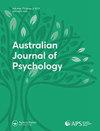The role of death fears and attachment processes in social anxiety: a novel hypothesis explored
IF 3.6
4区 心理学
Q1 PSYCHOLOGY, MULTIDISCIPLINARY
引用次数: 2
Abstract
ABSTRACT Objective: Research suggests an association between the fear of death and social anxiety, but the mechanisms through which these constructs are related remain unclear. From a socio-evolutionary perspective, abandonment and rejection are associated with premature death, and appraisals of the importance of social relationships for maintaining survival are influenced by one’s upbringing, reflected in individual differences in attachment patterns. We thus explored whether different attachment dimensions mediated the relationship between death anxiety and social anxiety to differing degrees, according to the value afforded by these dimensions to the importance of relationships for survival. Method: Self-report data on death anxiety, social anxiety, and two dimensions of attachment (anxiety and avoidance) was collected from 93 participants with varying levels of social anxiety. Results: Supporting the hypotheses, there was an indirect effect of death anxiety on social anxiety via attachment anxiety, even when fear of own death and fear of other’s death were analysed separately. No indirect effect via attachment avoidance was observed. Conclusions: These results clarify the mechanisms underpinning the association between social anxiety and the fear of death, and suggest that a socio-evolutionary framework provides utility in better understanding these clinical constructs. KEY POINTS What is already known about this topic: (1) Research demonstrates a hitherto unclear association between the experience of social anxiety and underlying death fears. (2) A socio-evolutionary approach highlights the intimate relationship between abandonment/rejection and premature death during our evolutionary history. (3) Appraisals of the importance of social relationships for maintaining survival ought to be influenced by developmental experiences. What this topic adds: (1) We propose that variation in these appraisals are reflected in the different attachment dimensions (anxiety and avoidance). (2) In support of this, we found that attachment anxiety mediated the relationship between death anxiety and social anxiety, whereas attachment avoidance did not. (3) These results clarify the mechanisms underpinning the connection between social anxiety and underlying death fears and emphasise the utility of socio-evolutionary approaches to clinical syndromes.死亡恐惧和依恋过程在社交焦虑中的作用:一个新的假说
摘要目的:研究表明死亡恐惧与社交焦虑之间存在关联,但这些构式之间的关联机制尚不清楚。从社会进化的角度来看,遗弃和拒绝与过早死亡有关,对维持生存的社会关系重要性的评价受到个人成长的影响,这反映在依恋模式的个体差异上。因此,我们根据这些维度对生存关系的重要性所提供的价值,探讨了不同依恋维度是否在不同程度上介导了死亡焦虑和社交焦虑之间的关系。方法:收集93名不同程度社交焦虑的参与者的死亡焦虑、社交焦虑和依恋两个维度(焦虑和回避)的自我报告数据。结果:支持假设,死亡焦虑通过依恋焦虑间接影响社交焦虑,即使在对自己死亡的恐惧和对他人死亡的恐惧分开分析时也是如此。没有观察到依恋回避的间接影响。结论:这些结果阐明了社交焦虑和死亡恐惧之间关联的机制,并表明社会进化框架有助于更好地理解这些临床结构。关于这个话题的已知内容:(1)研究表明,社交焦虑的经历与潜在的死亡恐惧之间存在迄今为止尚不清楚的联系。(2)社会进化方法强调了人类进化史上遗弃/拒绝与过早死亡之间的密切关系。(3)社会关系对维持生存的重要性的评价应当受到发展经验的影响。本课题补充的内容:(1)我们认为这些评价的变化反映在不同的依恋维度(焦虑和回避)上。(2)依恋焦虑在死亡焦虑和社交焦虑之间起中介作用,而依恋回避在死亡焦虑和社交焦虑之间不起中介作用。(3)这些结果阐明了社会焦虑与潜在死亡恐惧之间联系的机制,并强调了社会进化方法对临床综合征的效用。
本文章由计算机程序翻译,如有差异,请以英文原文为准。
求助全文
约1分钟内获得全文
求助全文
来源期刊

Australian Journal of Psychology
PSYCHOLOGY, MULTIDISCIPLINARY-
CiteScore
5.50
自引率
0.00%
发文量
19
期刊介绍:
Australian Journal of Psychology is the premier scientific journal of the Australian Psychological Society. It covers the entire spectrum of psychological research and receives articles on all topics within the broad scope of the discipline. The journal publishes high quality peer-reviewed articles with reviewers and associate editors providing detailed assistance to authors to reach publication. The journal publishes reports of experimental and survey studies, including reports of qualitative investigations, on pure and applied topics in the field of psychology. Articles on clinical psychology or on the professional concerns of applied psychology should be submitted to our sister journals, Australian Psychologist or Clinical Psychologist. The journal publishes occasional reviews of specific topics, theoretical pieces and commentaries on methodological issues. There are also solicited book reviews and comments Annual special issues devoted to a single topic, and guest edited by a specialist editor, are published. The journal regards itself as international in vision and will accept submissions from psychologists in all countries.
 求助内容:
求助内容: 应助结果提醒方式:
应助结果提醒方式:


